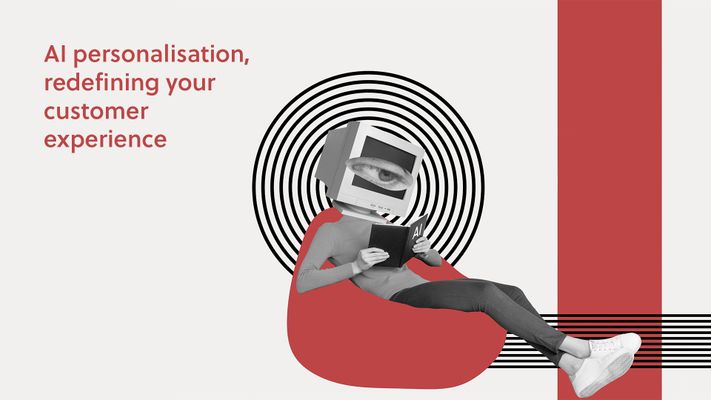AI personalisation, redefining your customer experience
AI personalisation is a new and emerging marketing trend that could optimise your interactions with your customers. And don't worry about being replaced by robots, working with AI might just be one of the best marketing decisions you make. How it works is that you use algorithms and advanced AI to analyse a large pool of data. The purpose is to understand consumer data and apply it to their preferences whilst acknowledging people’s data privacy. Relevant AI recommendations are made, and value is extracted from data to form a more enjoyable user experience. AI personalisation is pivotal for leveraging your business as it meets the expectations and needs of consumers who crave personalised, specific content. And by implementing AI personalisation into your marketing strategy you are effectively combatting decision fatigue. Decision fatigue is the term to describe the overwhelming feeling that there’s so much out there on the internet that we don’t have enough time to consume everything. And our attention is shared across multiple social media platforms and brands. AI personalisation is the solution to providing relevant data that will transform your marketing strategies, leading to higher conversion rates and happier customers. By enhancing the customer experience, AI personalisation becomes key to your business's success, significantly impacting the customer journey. Read on to discover how to use AI personalisation to redefine the customer experience.
AI personalisation: recommendations
Part of AI personalisation is product recommendations. Product recommendations form due to machine learning. Machine learning enables AI to identify patterns in consumer data, which predicts future shopping behaviour based on browsing and shopping history. For example, if you’re an avid lover of mayonnaise, the Belgian brand Devos & Lemmens, you might decide to subscribe and save on Amazon. So, you have mayonnaise delivered to your door every 5 weeks. As a result of ordering mayonnaise, you now receive Amazon emails about Devos & Lemmens pickles, other brands of mayonnaise that aren't as tasty, and lemon-flavoured mayonnaise.  Amazon knows exactly what they are doing by emailing you ‘you might like this’ with other related products. And now your inbox is filled with tasty recommendations and because Amazon knows what your buying habits are it knows what to recommend. Sometimes the recommendations will miss the mark as they are too general and other times, they get you to your basket before you can say 'mayonnaiseisamuchbettersaucethanketchupandpeoplewholikeketchupshouldreevulatettheirlifechoices.’
Amazon knows exactly what they are doing by emailing you ‘you might like this’ with other related products. And now your inbox is filled with tasty recommendations and because Amazon knows what your buying habits are it knows what to recommend. Sometimes the recommendations will miss the mark as they are too general and other times, they get you to your basket before you can say 'mayonnaiseisamuchbettersaucethanketchupandpeoplewholikeketchupshouldreevulatettheirlifechoices.’
Fun fact: 35% of purchases are as a result of Amazon product recommendations
But product recommendations don’t just appear in emails, they also appear on the e-commerce site you are on. For example, Amazon has recommendations like ‘Deals for you’, ‘Books that you may like’, and ‘More picks for you.’ So, if your business isn’t taking advantage of product recommendations, it is a good place to start. The impact of receiving product recommendations could foster customer loyalty and at the very least intrigue interest. But what are the main types of product recommendations?
Types of product recommendations
Recommendations must be:
- user-based
- product-based
- expert-based
User-based recommendations
User-based recommendations would be the ‘customers also bought’ button on Amazon. They work because we are often convinced by reviews and the behaviours of other consumers. So with user-based recommendations, the suggestions are making the assumption that because other consumers have also bought said items that you might be interested in what others have bought. And it seems that part of user-based recommendations is appealing to the consumer’s curiosity, a powerful motivator to purchase as the consumer wants to see what others have bought so they can make informed decisions about what products they wish to buy.
Product-based recommendations
Product-based recommendations are ‘similar to’ the item you have bought. This type of product recommendation would suit product description pages. The AI would define what constitutes as similar, but you get to set the range. For example, you can ensure that similar items are all in the same price range. You set the boundaries.
Expert-based recommendations
Expert-based recommendations are manual. You determine which recommendations are displayed for each product. There are two modes of expert-based recommendations:
Always recommend- meaning that you get to control which products you want to be shown.
Do not recommend- choosing which products you do not want to be listed in the recommendations.
The advantage of expert-based recommendations is that they are curated which will enhance the customer experience. These product recommendations differ from AI recommendations as they are from specialists who the consumer can trust to help them make informed buying decisions. Additionally, with expert recommendations, the product recommendations are to be customer-centric and to harness customer cravings. Part of harnessing customer cravings is optimising the product display page, and through AI the customer experience is not only prioritised but also enhanced. But service-based businesses are less subtle, and they don’t need to be. One example of a service-based business utilising AI personalisation is through specific email subject lines. Imagine you are an entrepreneur planning to build a business around your love of peanut butter. You’ve signed up for the www.becomeyourownbusinessman.com newsletter and receive an email with the subject line: “Matt, stop eating your stock.”  This direct messaging is effective because it addresses you personally and aligns with your interests. The wording draws you in, promising that the solution is in the email. Standing out in a crowded inbox is essential, as many emails are ignored, binned, or skimmed. Equally, we all dislike being called the wrong name, so being addressed as "Dear John" instead of "Dear Friend" or "Dear I forgot your name" means a lot to consumers. Personalisation shows that the brand cares and pays attention to details. With 80% of consumers more likely to make purchases from brands that engage in personalised advertising, not investing in this approach would be a missed opportunity. As a business interested in email marketing, you should consider personalising your email subject lines, as it significantly increases your open rates.
This direct messaging is effective because it addresses you personally and aligns with your interests. The wording draws you in, promising that the solution is in the email. Standing out in a crowded inbox is essential, as many emails are ignored, binned, or skimmed. Equally, we all dislike being called the wrong name, so being addressed as "Dear John" instead of "Dear Friend" or "Dear I forgot your name" means a lot to consumers. Personalisation shows that the brand cares and pays attention to details. With 80% of consumers more likely to make purchases from brands that engage in personalised advertising, not investing in this approach would be a missed opportunity. As a business interested in email marketing, you should consider personalising your email subject lines, as it significantly increases your open rates.
Do consumers know what they want?
 The truth is consumers often need to learn what they are looking for, but they know what they like, and they know what they care about. For example, you might be looking for sustainable, organic cotton tampons so you purchase Here We Flo tampons. So, AI personalisation guides consumers to products that align with their values. And now you know that AI personalisation works as it collects data to 'know' the consumer but want to know more about how?
The truth is consumers often need to learn what they are looking for, but they know what they like, and they know what they care about. For example, you might be looking for sustainable, organic cotton tampons so you purchase Here We Flo tampons. So, AI personalisation guides consumers to products that align with their values. And now you know that AI personalisation works as it collects data to 'know' the consumer but want to know more about how?
What does AI personalisation look like? The benefits
 Consumers want to make choices and they want it on their terms. They want to feel heard but they don’t want it to feel like decisions are being made for them, at least not in an annoying way. So, to bridge that gap, the consumer can choose to opt in—for example, by allowing cookies that ask permission to store their data and use it for potentially helpful shopping recommendations. Also, opting in gives power to the consumers whilst addressing privacy concerns. Personalised marketing preferences offer several benefits for consumers and businesses.
Consumers want to make choices and they want it on their terms. They want to feel heard but they don’t want it to feel like decisions are being made for them, at least not in an annoying way. So, to bridge that gap, the consumer can choose to opt in—for example, by allowing cookies that ask permission to store their data and use it for potentially helpful shopping recommendations. Also, opting in gives power to the consumers whilst addressing privacy concerns. Personalised marketing preferences offer several benefits for consumers and businesses.
Here are five detailed below:
Greater productivity- personalised marketing is specific to the individual. It drives customer performance and results in better customer outcomes. Greater productivity is due to the personalisation being meaningful and relevant. Time is saved with AI personalisation without the quality being affected (in theory). Improved customer experience- relevancy naturally leads to an improved customer experience; product recommendations are of interest rather than random. The customer is made to feel valued, and known by name, not just a number. The customer feels like they are in control, that they are heard. Customer engagement and feedback- with customer engagement it starts with understanding and analysing customer data. The data must be beyond the simple ‘Jon, 24, Hertfordshire.’ The data should include demographics, behaviour, past shopping history, and preferences to create more personalised campaigns. Another part of that is empathy, using empathetic messaging is pivotal.  With personalised marketing, there is the expectation for brands to connect to consumers on a personal and emotional level. It’s not as simple as expressing views, it is meeting their interests and relating. Customers want to know that the brand they support is genuine and reliable before they can commit. Beyond that, it is necessary to utilise customer feedback using reviews and forms to understand ‘the who.’ Customer feedback must not just be read, it must be woven into your marketing strategy. Lead nurturing is how you convince them- lead nurturing is essential as you are working on prospects who are not ready to buy. Personalisation is how you convince them. With 71% of consumers expecting personalised interactions, it is necessary to incorporate it into your marketing strategy. You will know their pain points and what they want to gain – and that is how you convince them. But how can you know this? It’s all about how you gather your data. You can use analytic tools to track your leads’ behaviour. What you’ll need to know is the pages they have visited, the time spent on each page and what actions they have taken. A sure way of doing this is through cookies and forms on your website. Another way to lead nurturing is by tracking your leads’ social media usage so you can map out their needs. Customer retention- retaining customers is almost as important as gaining new customers. Personalised marketing is key for the growth of your business, but understanding the challenges of engaging the customer is necessary. Primarily, the issue is decision fatigue- every day we are faced with many choices. We are bombarded with a pink headband from Amazon, a pink headband from ASOS, from Etsy, from Cider, we don't know what choice to make. But to move from despair to hope- we need the decision to be made for us, we need to be engaged to commit to an action. Engagement can come from blogs, videos, and articles as long as there is interest. But why else will they stay? What are you offering? Incentives and rewards are needed to remain of interest to your consumer base. But make sure the incentives are specific to their needs. It is no good giving Lauren, who is allergic to pineapples, a discount code for pineapples. Incentivizing customers is based on individual preferences. Don’t just assume because it is a stereotype that British people love scones that everyone is going to want to go for afternoon tea (you’re weird if that’s not your thing though.) Bottom line - don’t assume and don’t make calls based on averages. Make decisions based on the person. With this type of personalisation, timing is everything. For increased conversion rates the right products or services must be presented to the right people at the right time. The key is to anticipate their needs which leads to happier customers.
With personalised marketing, there is the expectation for brands to connect to consumers on a personal and emotional level. It’s not as simple as expressing views, it is meeting their interests and relating. Customers want to know that the brand they support is genuine and reliable before they can commit. Beyond that, it is necessary to utilise customer feedback using reviews and forms to understand ‘the who.’ Customer feedback must not just be read, it must be woven into your marketing strategy. Lead nurturing is how you convince them- lead nurturing is essential as you are working on prospects who are not ready to buy. Personalisation is how you convince them. With 71% of consumers expecting personalised interactions, it is necessary to incorporate it into your marketing strategy. You will know their pain points and what they want to gain – and that is how you convince them. But how can you know this? It’s all about how you gather your data. You can use analytic tools to track your leads’ behaviour. What you’ll need to know is the pages they have visited, the time spent on each page and what actions they have taken. A sure way of doing this is through cookies and forms on your website. Another way to lead nurturing is by tracking your leads’ social media usage so you can map out their needs. Customer retention- retaining customers is almost as important as gaining new customers. Personalised marketing is key for the growth of your business, but understanding the challenges of engaging the customer is necessary. Primarily, the issue is decision fatigue- every day we are faced with many choices. We are bombarded with a pink headband from Amazon, a pink headband from ASOS, from Etsy, from Cider, we don't know what choice to make. But to move from despair to hope- we need the decision to be made for us, we need to be engaged to commit to an action. Engagement can come from blogs, videos, and articles as long as there is interest. But why else will they stay? What are you offering? Incentives and rewards are needed to remain of interest to your consumer base. But make sure the incentives are specific to their needs. It is no good giving Lauren, who is allergic to pineapples, a discount code for pineapples. Incentivizing customers is based on individual preferences. Don’t just assume because it is a stereotype that British people love scones that everyone is going to want to go for afternoon tea (you’re weird if that’s not your thing though.) Bottom line - don’t assume and don’t make calls based on averages. Make decisions based on the person. With this type of personalisation, timing is everything. For increased conversion rates the right products or services must be presented to the right people at the right time. The key is to anticipate their needs which leads to happier customers. 
How to use AI personalisation?
AI personalisation will primarily be used for email marketing, websites, SMS marketing and ads. AI personalisation in SMS marketing has the potential to lead to greater consumer engagement. By analysing customer data, behaviour, and preferences AI can tailor SMS messages to each individual. The outcome of this is delivering personalised offers, recommendations, and reminders. This level of customisation can lead to higher open rates, click-through rates, and ultimately, increased sales for businesses. For example, personalisation leads to upselling on Amazon, which is ordering an item that is more expensive than you planned to buy. But with recommendations, it is important not to overwhelm and to focus on a few product recommendations. With predictive personalisation, you will be able to predict consumer behaviour and needs based on a pattern of past interactions (and AI algorithms). Predictive personalisation aims to offer tailored messaging and products that will have a significant impact on the customer’s purchasing decisions.
So what does email personalisation look like?
With email personalisation, each email should be relevant to a specific person based on certain data like:
- Name
- Age
- Gender
- Location
- Preferences
- Behaviours
Email personalisation works because the content is relevant and timely- with AI personalisation you will be able to identify how your subscribers will receive your content and if they are ready for it. How can you use email marketing strategies? The data provided should enable you to build relationships with your subscribers, for example, you will know which CTA’s (calls to action) will work on specific people. Your goal should be to engage which could lead to another goal like getting a subscriber of yours to click the button to your website. Once you figure out who your consumers are you can begin to deliver personalised content that addresses their needs. And what is the next step in the personalisation process that could revolutionise your approach to reaching prospects? One word - hyper-personalisation.
Hyper-personalisation
Hyper-personalisation is using artificial intelligence and machine learning to make a unique customer experience. Real-time data combined with AI reveals how each customer wants their content delivered and the next steps they will take. Hyper-personalisation is necessary to scaling as evidenced by a 2024 report on the state of personalisation by Twilio Segment. The report revealed that brands risk losing customer loyalty if they fail to make their customers feel valued and important. Yet scaling is the challenge as with hyper-personalisation, it gets more expensive and complicated as you expand. There is the expectation to excel at analytics, data management, decision making and execution. The result of that is being provided context with every single interaction. However, this is only effective when you are not dealing with bad-quality data that isn’t irrelevant or outdated. Additionally, the challenge is for marketers to sif through large volumes of data to find useful insights for personalised content. The reality is that scaling your business with hyper-personalisation requires not only funding but also time and training. Implementing this approach necessitates a well-developed technological infrastructure to integrate seamlessly into your company’s digital marketing processes.
Other challenges to hyper-personalisation
AI relies on high-quality well-organised data to scale and that requires the right technology to do so effectively. Firstly, the data must be unified, one way is by having a single customer view. A single customer view is a database with customer profiles, which will show their site activity, their purchase history, customer interactions and product recommendations. A single customer view will allow you to create targeted customer segments by providing you with a complete view of your customers. The data will need to be activated and can be unified through a customer data engine. However, it may not be possible for every business to take advantage of hyper-personalisation as it relies on substantial investments in data analytics, technology, and skilled personnel. Additionally, the challenge in scaling with hyper-personalisation is recognising that there is the risk of overwhelming and annoying customers. We all hate getting the email ‘ Hey I see you, Lydia, with those 42 pieces of dark chocolate in your basket. Don’t deny yourself.’  Equally, there are ethical considerations regarding how data and how much is gathered. For AI to achieve hyper-personalisation at scale it would need to violate privacy as it often is invasive.
Equally, there are ethical considerations regarding how data and how much is gathered. For AI to achieve hyper-personalisation at scale it would need to violate privacy as it often is invasive.
Privacy and data violations- legal regulations
To take advantage of AI personalisation you might be in the position of violating privacy. Businesses will need access to considerable amounts of real-time data which raises significant privacy concerns. So what data is captured? The data captured is personal and transactional (purchasing history, names); the worry for some consumers is that this data is exploitative. However, the data is necessary for marketing strategies as it provides relevant and contextual information about consumers. So, how do you make it work? So, businesses must take privacy concerns seriously and comply with GDPR, online privacy laws, and national and international laws. Businesses risk alienating their customer base and getting in trouble with the law if they do not understand the importance of understanding privacy laws. Being irresponsible with data can lead to large fines. To avoid that, companies are legally required to ask for consent when accessing data, for example through cookies. Another way of asking for consent is through asking for feedback and having consumers complete surveys. Ultimately, businesses must maintain transparency in their data collection practices. The solution is for businesses to prioritise privacy by maintaining transparency and security by storing data for a limited amount of time and using data to serve the needs of the consumer. Privacy strategies within marketing let consumers make decisions about what information they allow to be shared and stored. Additionally, obtaining consent allows consumers to opt in and out of the data collection process. Respecting the consumer’s privacy preferences is paramount and will allow you as a business to reap the rewards. Keep the Data Protection Act in mind when processing and implementing consumer data into your strategies.
Authenticity
Trust. People will likely prefer humans to AI. At least, that’s what they think. As long as you incorporate the human touch into your messaging then your brand will be trusted. And as brilliant as AI is, beware of being overly reliant on it. Consumers want brands to be honest about their values, to use AI responsibly and admit to it. Since the rise of ChatGPT, consumers are more aware of content generated by AI and are ultimately less inclined to engage with it. Recently, it was found in a study by Bynder that half of consumers can detect AI-generated content. But what consumers want is honesty – they don’t want businesses to pretend they don’t use AI and they don’t want every interaction to look artificial.  Consumers are not looking for content that is ‘too polished’ they are looking for content that shares their values and their own belief system. Content that engages with consumers on TikTok, X, Instagram and Facebook. What they don’t want is the ‘Artificial’ part of Artificial Intelligence. The challenge is that AI content tends to be quickly and cheaply made, however as the AI technology evolves, there’s the expectation that it will increase in accuracy and relevance. Ultimately, consumers want to be able to vouch for you. They don’t want to deal with irrelevance and equally, they don’t want to bear the responsibility of supporting a brand with questionable ethics.
Consumers are not looking for content that is ‘too polished’ they are looking for content that shares their values and their own belief system. Content that engages with consumers on TikTok, X, Instagram and Facebook. What they don’t want is the ‘Artificial’ part of Artificial Intelligence. The challenge is that AI content tends to be quickly and cheaply made, however as the AI technology evolves, there’s the expectation that it will increase in accuracy and relevance. Ultimately, consumers want to be able to vouch for you. They don’t want to deal with irrelevance and equally, they don’t want to bear the responsibility of supporting a brand with questionable ethics.
Investing in AI software
Having AI software is necessary for personalised customer experiences. You will be faced with two options:
- Investing in AI software (external)
- Building AI software in-house
In-house AI requires substantial investments however the benefits are flexibility and long-term control over your projects. Outsourcing is more affordable and suitable for short-term projects. Whatever you decide it will take investment and considerable thought to see whether one or the other is more beneficial for your business.
Final thoughts
AI personalisation is necessary for not only effective conversion but also customer retention. AI personalisation utilises advanced algorithms to analyse large pools of data and customise the consumer experience. Whilst, hyper-personalisation is a tool for enhancing customer experience, there are ethical implications with pools of data being stored and shared. Yet, the job of AI is to drive consumer engagement through tailored suggestions.  The goal remains consistent: to make every consumer feel valued and understood as individuals not as groups, as well as building trust and proving authenticity. Being human is an important aspect within your marketing strategy. But part of the personalisation process is scaling and with that, there is the risk of appearing distant. However, by harnessing customer data and feedback, businesses can refine their marketing strategies, leading to more meaningful interactions and higher customer satisfaction. Ultimately, AI personalisation is a pivotal tool to thrive as a business today. Once and for all, you will be abandoning the one-size-fits-all mentality and shifting towards successful personalised marketing approaches. If you need help with things like customer retention, lead nurturing or improving customer experience, say hi 😊.
The goal remains consistent: to make every consumer feel valued and understood as individuals not as groups, as well as building trust and proving authenticity. Being human is an important aspect within your marketing strategy. But part of the personalisation process is scaling and with that, there is the risk of appearing distant. However, by harnessing customer data and feedback, businesses can refine their marketing strategies, leading to more meaningful interactions and higher customer satisfaction. Ultimately, AI personalisation is a pivotal tool to thrive as a business today. Once and for all, you will be abandoning the one-size-fits-all mentality and shifting towards successful personalised marketing approaches. If you need help with things like customer retention, lead nurturing or improving customer experience, say hi 😊.













